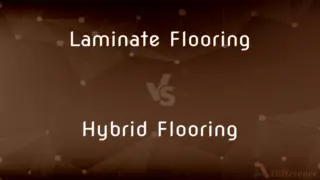Mold vs. Moss — What's the Difference?
By Tayyaba Rehman & Fiza Rafique — Updated on April 5, 2024
Mold is a fungus thriving in damp, warm environments, decomposing organic material, whereas moss is a non-vascular plant favoring moist, shady locations.

Difference Between Mold and Moss
Table of Contents
ADVERTISEMENT
Key Differences
Mold is a type of fungus that grows in multicellular filaments called hyphae, thriving in damp, warm environments and decomposing organic matter. Whereas moss, being a non-vascular plant, primarily grows in moist, shaded areas, forming dense green mats or clumps on soil, rocks, or trees.
Molds can cause health issues such as allergies and respiratory problems when inhaled, especially in indoor environments where their spores can accumulate. Moss, however, is not known to negatively impact human health and is often used in gardens and landscapes for aesthetic purposes or to prevent soil erosion.
While mold can grow on a variety of organic materials including wood, paper, and food, causing damage and decay, moss primarily grows on non-decaying surfaces like rocks and tree trunks, where it can sometimes protect the surface by retaining moisture.
Mold is generally considered a problem, especially when it grows indoors, requiring removal and prevention measures. In contrast, moss is often appreciated for its aesthetic appeal and environmental benefits, such as providing habitat for wildlife and contributing to the water cycle.
Comparison Chart
Type
Fungus
Non-vascular plant
ADVERTISEMENT
Environment
Damp, warm
Moist, shaded
Reproduction
Spores, airborne
Spores, requires moisture
Health Impact
Can cause allergies, respiratory problems
Not harmful, used in landscapes
Growth Surface
Organic materials (wood, food)
Non-decaying surfaces (rocks, trees)
Compare with Definitions
Mold
Mold in homes often requires professional removal to prevent health risks.
Professional mold remediation can address extensive infestations.
Moss
Moss can help prevent soil erosion by retaining moisture and binding soil.
Moss is often introduced to stabilize stream banks.
Mold
Mold breaks down dead organic matter, recycling nutrients in ecosystems.
Mold growing on a fallen log helps decompose it.
Moss
Moss is used in gardens for its beauty and to create a sense of age and tranquility.
Moss gardens offer a unique, serene landscape element.
Mold
Mold can proliferate in buildings, causing health issues.
Mold found in damp basements can aggravate allergies.
Moss
Moss requires minimal upkeep, making it ideal for low-maintenance gardening.
Moss lawns are becoming popular as eco-friendly alternatives.
Mold
Mold reproduces via spores that can spread through air.
Mold spores can be found in indoor air samples.
Moss
Moss provides habitat and food for wildlife in moist environments.
Moss-covered rocks are often teeming with small insects.
Mold
Thousands of mold species exist, each with unique characteristics.
Black mold is notorious for its potential health risks.
Moss
Moss can indicate air and water quality, as it absorbs nutrients and pollutants from the environment.
High moss diversity can signal a clean environment.
Mold
A mold (US) or mould (UK, NZ, AU, ZA, IN, CA, IE) is a fungus that grows in the form of multicellular filaments called hyphae. In contrast, fungi that can adopt a single-celled growth habit are called yeasts.
Moss
Mosses are small, non-vascular flowerless plants in the taxonomic division Bryophyta (, ) sensu stricto. However, Bryophyta (sensu lato, Schimp.
Mold
A town in north-eastern Wales, administrative centre of Flintshire; population 10,500 (est. 2009).
Moss
A small flowerless green plant which lacks true roots, growing in low carpets or rounded cushions in damp habitats and reproducing by means of spores released from stalked capsules
The bog is home to rare mosses
The trees are overgrown with vines and moss
Mold
A hollow form or matrix for shaping a fluid or plastic substance.
Moss
A green colour like that of moss.
Mold
A frame or model around or on which something is formed or shaped.
Moss
A bog, especially a peat bog.
Mold
Something that is made in or shaped on a mold.
Moss
Cover with moss
The mossed old trees
Mold
The shape or pattern of a mold.
Moss
Any of various green, usually small, nonvascular plants of the division Bryophyta, having leaflike structures arranged around the stem and spores borne in a capsule.
Mold
General shape or form
The oval mold of her face.
Moss
A patch or covering of such plants.
Mold
Distinctive character or type
A leader in the mold of her predecessors.
Moss
Any of various other unrelated plants having a similar appearance or manner of growth, such as Irish moss, Spanish moss, and the club mosses.
Mold
A fixed or restrictive pattern or form
A method of scientific investigation that broke the mold and led to a new discovery.
Moss
To cover with moss.
Mold
(Architecture) See molding.
Moss
Any of various small, green, seedless plants growing on the ground or on the surfaces of trees, stones, etc.; now specifically, a plant of the phylum Bryophyta (formerly division Musci).
Mold
Any of various filamentous fungi that grow on and contribute to the decay of organic matter.
Moss
(countable) A kind or species of such plants.
Mold
A growth of such fungi.
Moss
(informal) Any alga, lichen, bryophyte, or other plant of seemingly simple structure.
Spanish moss
Irish moss
Club moss
Mold
Any of various other saprophytic or parasitic organisms that resemble fungi, such as slime molds or water molds.
Moss
A bog; a fen.
The mosses of the Scottish border
Mold
Loose friable soil, rich in humus and fit for planting.
Moss
(intransitive) To become covered with moss.
An oak whose boughs were mossed with age.
Mold
The earth; the ground.
Moss
(transitive) To cover (something) with moss.
Mold
The earth of the grave.
Moss
A cryptogamous plant of a cellular structure, with distinct stem and simple leaves. The fruit is a small capsule usually opening by an apical lid, and so discharging the spores. There are many species, collectively termed Musci, growing on the earth, on rocks, and trunks of trees, etc., and a few in running water.
Mold
(Archaic) Earth as the substance of the human body.
Moss
A bog; a morass; a place containing peat; as, the mosses of the Scottish border.
Mold
To form (something) out of a fluid or plastic material
Molded a cup out of clay.
Moss
To cover or overgrow with moss.
An oak whose boughs were mossed with age.
Mold
To form into a particular shape; give shape to
Molded the clay into a ball.
Moss
Tiny leafy-stemmed flowerless plants
Mold
To guide or determine the growth or development of; influence
A teacher who helps to mold the minds of his students.
Mold
To fit closely by following the contours of (the body). Used of clothing.
Mold
To assume a certain shape
Shoes that gradually molded to my feet.
Mold
To become moldy.
Mold
A hollow form or matrix for shaping a fluid or plastic substance.
Mold
A frame or model around or on which something is formed or shaped.
Mold
Something that is made in or shaped on a mold.
Mold
The shape or pattern of a mold.
Mold
General shape or form.
The oval mold of her face
Mold
Distinctive character or type.
A leader in the mold of her predecessors
Mold
A fixed or restrictive pattern or form.
His method of scientific investigation broke the mold and led to a new discovery.
Mold
(architecture) A group of moldings.
The arch mold of a porch or doorway;
The pier mold of a Gothic pier, meaning the whole profile, section, or combination of parts
Mold
(anatomy) A fontanelle.
Mold
A natural substance in the form of a woolly or furry growth of tiny fungi that appears when organic material lies for a long time exposed to (usually warm and moist) air.
Mold
A fungus that creates such colored, furry growths.
Mold
Loose friable soil, rich in humus and fit for planting.
Mold
Earth, ground.
Mold
The top or crown of the head.
Mold
(transitive) To shape in or on a mold; to form into a particular shape; to give shape to.
Mold
(transitive) To guide or determine the growth or development of; influence
Mold
(transitive) To fit closely by following the contours of.
Mold
(transitive) To make a mold of or from (molten metal, for example) before casting.
Mold
(transitive) To ornament with moldings.
Mold
(intransitive) To be shaped in or as if in a mold.
These shoes gradually molded to my feet.
Mold
(transitive) To cause to become moldy; to cause mold to grow upon.
Mold
(intransitive) To become moldy; to be covered or filled, in whole or in part, with a mold.
Mold
To cover with mold or soil.
Mold
A spot; a blemish; a mole.
Mold
Crumbling, soft, friable earth; esp., earth containing the remains or constituents of organic matter, and suited to the growth of plants; soil.
Mold
Earthy material; the matter of which anything is formed; composing substance; material.
The etherial mold,Incapable of stain.
Nature formed me of her softest mold.
Mold
A growth of minute fungi of various kinds, esp. those of the great groups Hyphomycetes, and Physomycetes, forming on damp or decaying organic matter.
Mold
The matrix, or cavity, in which anything is shaped, and from which it takes its form; also, the body or mass containing the cavity; as, a sand mold; a jelly mold.
Mold
That on which, or in accordance with which, anything is modeled or formed; anything which serves to regulate the size, form, etc., as the pattern or templet used by a shipbuilder, carpenter, or mason.
The glass of fashion and the mold of form.
Mold
Cast; form; shape; character.
Crowned with an architrave of antique mold.
Mold
A group of moldings; as, the arch mold of a porch or doorway; the pier mold of a Gothic pier, meaning the whole profile, section, or combination of parts.
Mold
A fontanel.
Mold
A frame with a wire cloth bottom, on which the pump is drained to form a sheet, in making paper by hand.
Mold
To cover with mold or soil.
Mold
To cause to become moldy; to cause mold to grow upon.
Mold
To become moldy; to be covered or filled, in whole or in part, with a mold.
Mold
To form into a particular shape; to shape; to model; to fashion.
He forgeth and moldeth metals.
Did I request thee, Maker, from my clayTo mold me man?
Mold
To ornament by molding or carving the material of; as, a molded window jamb.
Mold
To knead; as, to mold dough or bread.
Mold
To form a mold of, as in sand, in which a casting may be made.
Mold
The distinctive form in which a thing is made;
Pottery of this cast was found throughout the region
Mold
Container into which liquid is poured to create a given shape when it hardens
Mold
Loose soil rich in organic matter
Mold
The process of becoming mildewed
Mold
A fungus that produces a superficial growth on various kinds of damp or decaying organic matter
Mold
Sculpture produced by molding
Mold
Form in clay, wax, etc;
Model a head with clay
Mold
Become moldy; spoil due to humidity;
The furniture molded in the old house
Mold
Form by pouring (e.g., wax or hot metal) into a cast or mold;
Cast a bronze sculpture
Mold
Make something, usually for a specific function;
She molded the riceballs carefully
Form cylinders from the dough
Shape a figure
Work the metal into a sword
Mold
Fit tightly, follow the contours of;
The dress molds her beautiful figure
Mold
Shape or influence; give direction to;
Experience often determines ability
Mold public opinion
Common Curiosities
How does mold affect health?
Mold can cause allergies and respiratory problems if its spores are inhaled.
Can moss be beneficial?
Yes, moss can prevent soil erosion, beautify gardens, and provide habitats for wildlife.
How do mold and moss reproduce?
Both reproduce through spores, but mold spores are airborne, whereas moss spores require moisture to germinate.
What is mold?
Mold is a type of fungus that grows in damp conditions and decomposes organic material.
Where does moss grow?
Moss grows in moist, shaded areas, often on soil, rocks, or tree trunks.
Is mold harmful to structures?
Yes, mold can damage organic materials like wood and paper in buildings.
Can mold be found outdoors?
Yes, mold can grow outdoors, especially in damp, organic environments.
How can mold growth be prevented?
Controlling moisture and humidity indoors is key to preventing mold growth.
How does moss benefit the environment?
Moss contributes to the water cycle, provides wildlife habitat, and can indicate environmental health.
Why is moss used in gardens?
Moss is appreciated for its aesthetic appeal and ability to create a tranquil garden atmosphere.
How do you remove mold?
Mold removal often requires cleaning with specialized solutions and sometimes professional remediation.
Are all molds dangerous?
Not all molds are harmful, but some can produce toxins or cause health issues.
Does moss have any commercial uses?
Yes, moss is used in landscaping, as a soil conditioner, and in crafts for its decorative qualities.
Can moss grow indoors?
While uncommon, moss can grow indoors in very moist conditions, such as on walls in bathrooms.
What makes moss different from other plants?
Moss is a non-vascular plant, meaning it doesn't have traditional roots, stems, or leaves like other plants.
Share Your Discovery

Previous Comparison
Dossier vs. Document
Next Comparison
Specialized vs. SpecialisedAuthor Spotlight
Written by
Tayyaba RehmanTayyaba Rehman is a distinguished writer, currently serving as a primary contributor to askdifference.com. As a researcher in semantics and etymology, Tayyaba's passion for the complexity of languages and their distinctions has found a perfect home on the platform. Tayyaba delves into the intricacies of language, distinguishing between commonly confused words and phrases, thereby providing clarity for readers worldwide.
Co-written by
Fiza RafiqueFiza Rafique is a skilled content writer at AskDifference.com, where she meticulously refines and enhances written pieces. Drawing from her vast editorial expertise, Fiza ensures clarity, accuracy, and precision in every article. Passionate about language, she continually seeks to elevate the quality of content for readers worldwide.















































